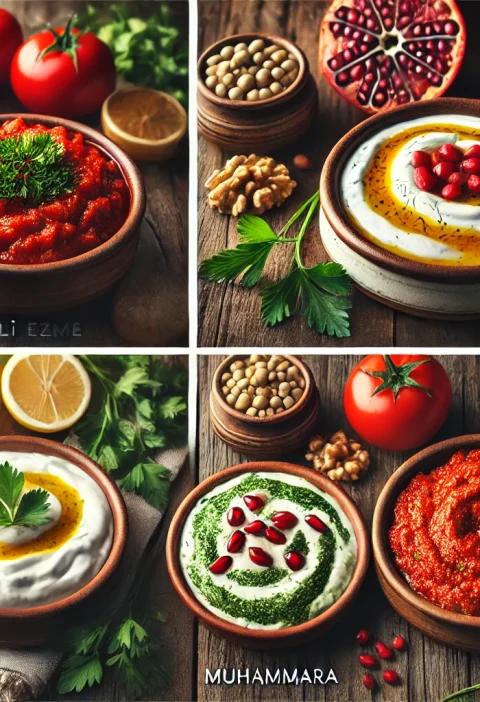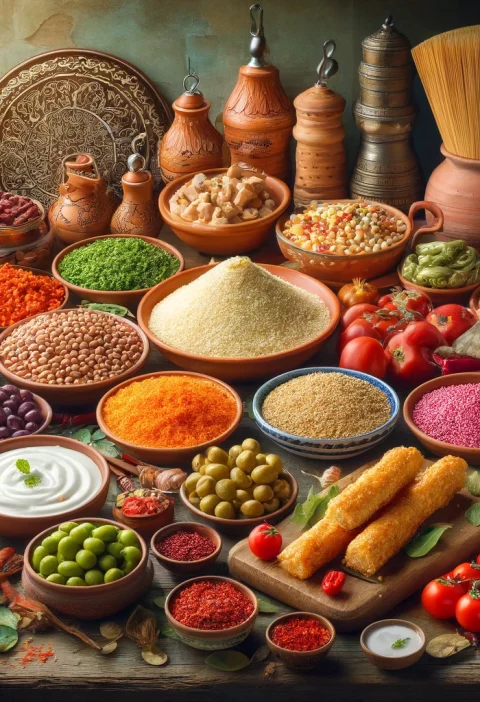Turkish cuisine is a vibrant and flavorful celebration of history and culture, particularly renowned for its delectable array of desserts. From the rich, syrupy layers of baklava to the simple, comforting texture of rice pudding, Turkish sweets offer something to satisfy every palate. In this article, we’ll embark on a culinary journey to explore some of the most traditional Turkish desserts, complete with recipes to bring these delightful treats into your own kitchen.
Introduction
Have you ever wondered why Turkish desserts taste so uniquely delicious? Is it the love and meticulous care put into their preparation, or perhaps the rich history behind each recipe that makes them so special? Let’s dive into the sweet world of Turkish desserts and find out!
What Makes Turkish Desserts Unique?
Turkish desserts are not only a treat for the palate but also a feast for the eyes. Known for their intricate preparation and rich, syrupy sweetness, these desserts often feature nuts, fruits, and spices, reflecting the diverse influences of the Ottoman Empire. The use of ingredients like rose water, honey, pistachios, and saffron adds an exotic touch that sets these sweets apart from other global treats.
Baklava: A Layered Masterpiece

Baklava is perhaps the most iconic of all Turkish desserts. This pastry is made of layers of filo dough, filled with chopped nuts, and soaked in honey or syrup. The key to perfect baklava is in the crispiness of the filo layers, contrasted with the sweet, rich filling. Here’s how you can make it at home:
- Ingredients: Filo pastry, unsalted butter, pistachios, sugar, lemon juice, water, and honey.
- Recipe: Layer the filo sheets brushed with melted butter in a baking dish, sprinkling chopped pistachios between the layers. Bake until golden and crisp, then pour a syrup made from sugar, water, lemon juice, and honey over the hot pastry.
Turkish Delight: A Chewy Classic

Turkish Delight, or lokum, offers a chewy texture and a sweet flavor that can be enhanced with various fillings like chopped dates, pistachios, or rose petals. The magic of Turkish Delight lies in its simplicity and the joy of choosing from its many flavors.
- Ingredients: Sugar, cornstarch, rose water, cream of tartar, and your choice of flavoring.
- Recipe: Dissolve sugar in water and add cream of tartar. Mix in cornstarch slurry and cook until a thick gel forms. Add flavorings, pour into molds, and cut into cubes once set.
Şekerpare: Sweet Bites of Joy

Şekerpare is one of the popular desserts in Turkish households, primarily during festive times. These sweet, soft cookies soaked in syrup are both satisfying and simple to make.
- Ingredients: Semolina, flour, butter, eggs, baking powder, and a syrup made from sugar, water, and lemon juice.
- Recipe: Mix semolina, flour, and baking powder. Combine with butter and eggs to form a dough. Shape into balls, bake until golden, then drench in warm lemony syrup.
Sütlaç: Turkish Rice Pudding

Sütlaç is a comforting rice pudding that is both creamy and light. This dessert is typically served cold and often garnished with cinnamon or ground nuts.
- Ingredients: Rice, milk, sugar, and rice flour.
- Recipe: Cook rice until soft, then mix with milk, sugar, and a little rice flour for thickening. Cook until creamy, then chill.
Revani: Semolina Cake Soaked in Syrup

Revani is a moist and tender semolina cake that is drenched in a light syrup, typically flavored with orange or lemon. This cake is delightfully spongey, owing its texture to the semolina and finely ground almonds often incorporated into the batter.
- Ingredients: Semolina, sugar, eggs, flour, baking powder, yogurt, and syrup made from sugar, water, and lemon juice.
- Recipe: Combine semolina, flour, and baking powder. In another bowl, beat sugar and eggs until fluffy, then fold in the yogurt. Combine with dry ingredients, pour into a baking dish, and bake until golden. Pour the lemon syrup over the cake while still hot.
Kadayif: Shredded Dough Delicacy

Kadayif is a less known but equally delicious cousin of baklava. It uses shredded phyllo dough, which is filled with nuts and soaked in syrup. The texture is uniquely crunchy and it’s a delightful alternative for those looking to explore beyond the traditional.
- Ingredients: Kadayif dough, melted butter, crushed pistachios or walnuts, and sweet syrup.
- Recipe: Untangle and fluff the kadayif dough and mix it with melted butter. Layer half in a baking dish, sprinkle with nuts, and cover with the remaining dough. Bake until crisp and golden, then drench in syrup.
Helva: A Versatile Confection

Helva refers to several different types of sweet desserts throughout the Middle East and Turkey. The Turkish versions often involve a flour-based or sesame paste-based dessert that can be flavored with pistachios, almonds, or vanilla.
- Ingredients: Flour or tahini, sugar, butter, and nuts.
- Recipe: For flour helva, roast the flour in butter until golden, then stir in a sugar syrup until it forms a dough-like consistency. Mix in nuts and shape as desired.
Lokma: Sweet Fried Dough Balls

Lokma are bite-sized, fluffy, fried dough balls that are soaked in syrup. They are often served as a treat during festive times and can be flavored with cinnamon or orange zest to add a unique twist to their sweetness.
- Ingredients: Flour, yeast, sugar, water, and syrup.
- Recipe: Mix yeast, sugar, and warm water and let it activate. Add flour to make a smooth batter. Let it rise until doubled. Drop spoonfuls of the batter into hot oil and fry until golden brown. Soak the hot lokma in syrup.
Aşure: Noah’s Pudding

Aşure is a rich, textured pudding made with grains, fruits, and nuts, symbolizing abundance and diversity. This dessert is traditionally made during Muharram, the first month of the Islamic calendar, and is shared with neighbors and friends as a symbol of friendship and unity.
- Ingredients: Wheat, chickpeas, beans, dried fruits, sugar, nuts, and pomegranate seeds.
- Recipe: Cook wheat, chickpeas, and beans until soft. Mix with chopped dried fruits and sugar, cook until thickened. Garnish with nuts and pomegranate seeds before serving.
Dondurma: Turkish Mastic Ice Cream

Dondurma is not just ice cream; it’s a chewy, stretchy confection unique to Turkey, thanks to the addition of mastic, a resin that imparts a chewy texture and a refreshing flavor. It’s often sold from street carts where vendors playfully tease customers with the ice cream’s elastic properties.
- Ingredients: Milk, sugar, salep, mastic gum, and cream.
- Recipe: Heat milk with sugar, mastic, and salep, a flour made from the tubers of orchids, until thickened. Cool and churn until creamy, then freeze.
How to Serve Turkish Desserts
Turkish desserts are typically served with Turkish tea or coffee, complementing the sweet flavors with the strong, bitter notes of the beverages. Presentation is key, so desserts are often garnished with additional nuts, fresh fruits, or drizzles of syrup to enhance their visual appeal as well as their taste.
Conclusion
Diving into the world of Turkish desserts is like exploring a treasure trove of flavors and textures. Whether you prefer the flaky layers of baklava or the creamy goodness of sütlaç, there’s no shortage of delightful sweets to discover and enjoy. Try making these traditional recipes at home and bring a taste of Turkish delight into your life!
FAQs
What is the most popular dessert in Turkey?
- Baklava is undoubtedly the most popular and beloved dessert across Turkey.
Can I make Turkish Delight without rose water?
- Yes, you can substitute rose water with orange blossom water or simply use vanilla for a different flavor.
Are Turkish desserts very sweet?
- Yes, most Turkish desserts are quite sweet, typically flavored with syrups or honey.
What is a good Turkish dessert for summer?
- Dondurma, the Turkish mastic ice cream, is perfect for summer due to its chewy texture and refreshing flavors.
How do I store Turkish desserts?
- Most Turkish desserts can be stored in an airtight container. Baklava and similar pastries are best kept at room temperature to maintain their crispness, while puddings and creams should be refrigerated.



